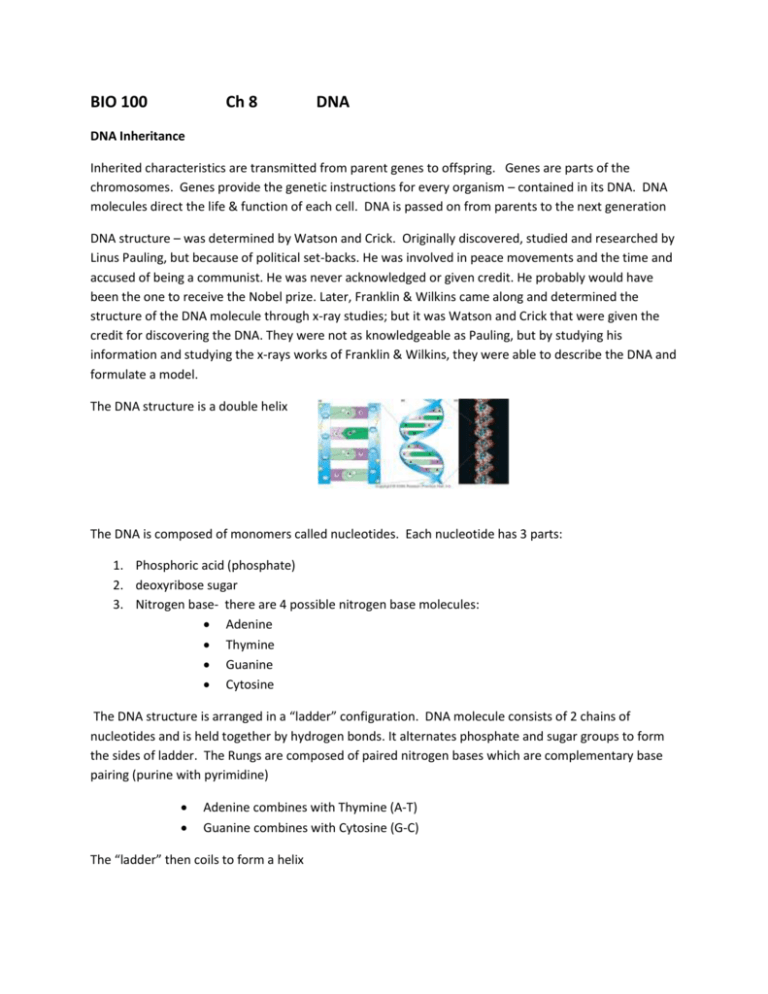
BIO 100
Ch 8
DNA
DNA Inheritance
Inherited characteristics are transmitted from parent genes to offspring. Genes are parts of the
chromosomes. Genes provide the genetic instructions for every organism – contained in its DNA. DNA
molecules direct the life & function of each cell. DNA is passed on from parents to the next generation
DNA structure – was determined by Watson and Crick. Originally discovered, studied and researched by
Linus Pauling, but because of political set-backs. He was involved in peace movements and the time and
accused of being a communist. He was never acknowledged or given credit. He probably would have
been the one to receive the Nobel prize. Later, Franklin & Wilkins came along and determined the
structure of the DNA molecule through x-ray studies; but it was Watson and Crick that were given the
credit for discovering the DNA. They were not as knowledgeable as Pauling, but by studying his
information and studying the x-rays works of Franklin & Wilkins, they were able to describe the DNA and
formulate a model.
The DNA structure is a double helix
A
T
T
C
C
C
C
G
G
A
A
T
T
C
G
A
T
T
T
A
G
G
A
A
Copyright © 2005 Pearson Prentice Hall, Inc.
The DNA is composed of monomers called nucleotides. Each nucleotide has 3 parts:
1. Phosphoric acid (phosphate)
2. deoxyribose sugar
3. Nitrogen base- there are 4 possible nitrogen base molecules:
Adenine
Thymine
Guanine
Cytosine
The DNA structure is arranged in a “ladder” configuration. DNA molecule consists of 2 chains of
nucleotides and is held together by hydrogen bonds. It alternates phosphate and sugar groups to form
the sides of ladder. The Rungs are composed of paired nitrogen bases which are complementary base
pairing (purine with pyrimidine)
Adenine combines with Thymine (A-T)
Guanine combines with Cytosine (G-C)
The “ladder” then coils to form a helix
DNA Replication
How then does DNA encode the amount of information required to build and operate an
organism?
How are we determined our individual height, bone frame, color of eyes, hair, and tone of voice?
What determines the variety in the species of dogs?
By the transmission of Genetic Information. This occurs during cell division
Cell Division
Cell division is required for growth & reproduction. The Cell cycle
p.114
Dividing cells will have limited differentiation or permanent differentiation
Stem cells: are the 1st few newly divided cells of a fertilized egg. They are not fully programmed to be
the specific cell they are going to be.
Cell Division – occurs in sexual reproduction in the eukaryotes cells – where fusion of 2 Gametes (egg &
sperm) take place. The fertilized egg cell undergoes the process of mitosis.
Asexual reproduction of cells – the cell is formed by a single parent without fusion of gametes. This
process produces offsprings genetically identical to the parent
Prokaryotes reproduce through binary fission – splitting in two
During DNA Replication – a variations in the organism’ characteristics is determined by the sequencing
of the four simple parts of the molecule (the nucleotides in the DNA). The 4 nitrogen bases are
arranged in any order. This occurs during the ‘S’ phase of the cell cycle (mitosis)..
When cells divide, the DNA is copied with accuracy. Chromosomes carry the genes - a chromosomes
consists of DNA and protein. Each double helix is the DNA components of a single chromosome.
Therefore, the nitrogen base pairing is the foundation of DNA replication.
DNA Enzyme – Ligase is what Bonds the DNA together; completes it. It also is responsible for repairing
any breaks in the sugar-phosphate backbone
Semi-conservative replication. Semiconservative = means that the two new DNA molecules will each
contain half “old” and half “new” DNA strands.
When the DNA divides, one parent DNA strand and its complementary
daughter DNA strand entwine into a helix formation
Each daughter DNA molecule consists of one new chain of nucleotides
that has paired up with the parent DNA molecule
The 2 daughter DNA molecules will be identical to the parent molecule







